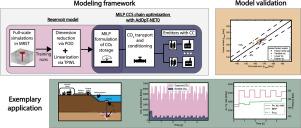优化碳捕获和储存基础设施,包括基于物理的储层建模
IF 3.9
2区 工程技术
Q2 COMPUTER SCIENCE, INTERDISCIPLINARY APPLICATIONS
引用次数: 0
摘要
碳捕获与封存(CCS)的部署需要一个潜在的复杂基础设施来运输和储存二氧化碳。其最佳部署是限制成本和及时部署符合雄心勃勃的缓解方案的关键。然而,确定基础设施的最佳设计在计算上具有挑战性。在这个框架内,混合整数线性规划(MILP)提供了一个计算上有效的解决方案,然而,它需要线性模型。毫不奇怪,地质储层通常被表示为静态汇,以恒定的注入速率和存储容量为参数。这种方法忽略了二氧化碳注入的动态特性,如油藏压力随时间的变化,限制了评估其对CCS链设计影响的能力。在这项工作中,我们提出了一种新的MILP模型,该模型将基于物理的油藏建模集成到CCS链优化中。在现有油藏降阶建模工作的基础上,我们将适当的正交分解和轨迹分段线性化相结合,以获得精确且计算效率高的CO2注入动态行为的MILP模型。与全尺寸油藏模拟相比,该模型计算注入井周围压力的精度为±5%,计算速度显著提高(500-1800倍)。我们通过一个通过CCS优化小型产业集群脱碳的说明性案例研究,展示了该模型在全链MILP模型中的应用,强调了该模型在设计链时将捕集技术与不同注入速率的最佳操作耦合在一起的能力,并确保了水库的安全约束。本文章由计算机程序翻译,如有差异,请以英文原文为准。

Optimizing carbon capture and storage infrastructure including physics-based reservoir modelling
The deployment of carbon capture and storage (CCS) requires a potentially complex infrastructure to transport and store CO2 underground. Its optimal roll-out is key to limiting costs and enabling a timely deployment in line with ambitious mitigation scenarios. However, identifying the optimal design of the infrastructure is computationally challenging. Within this framework, mixed-integer linear programming (MILP) offers a computationally effective solution, which, however, requires linear models. Not surprisingly, geological reservoirs are typically represented as static sinks with constant injection rates and storage capacities as parameters. This approach neglects the dynamic properties of CO2 injection, such as the reservoir pressure evolution over time, limiting the ability to evaluate their impact on the CCS chain design.
In this work, we propose a novel MILP model that integrates physics-based reservoir modelling into CCS chain optimization. Extending existing work on reduced-order modelling of reservoirs, we combine proper orthogonal decomposition and trajectory piecewise linearization to obtain a precise, yet computational efficient MILP model for the dynamic behaviour of CO2 injection. Compared to full-scale reservoir simulations, the model computes the pressure around the injection well with 5% accuracy and significant computational speed-ups (500-1800 times faster). We demonstrate its application in a full chain MILP model with an illustrative case study optimizing the decarbonization of a small industrial cluster through CCS, highlighting the model’s ability to couple optimal operation of capture technologies with varying injection rates and to ensure the reservoir safety constraints while designing the chain.
求助全文
通过发布文献求助,成功后即可免费获取论文全文。
去求助
来源期刊

Computers & Chemical Engineering
工程技术-工程:化工
CiteScore
8.70
自引率
14.00%
发文量
374
审稿时长
70 days
期刊介绍:
Computers & Chemical Engineering is primarily a journal of record for new developments in the application of computing and systems technology to chemical engineering problems.
 求助内容:
求助内容: 应助结果提醒方式:
应助结果提醒方式:


